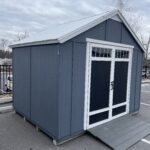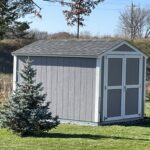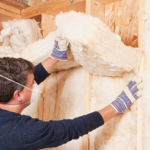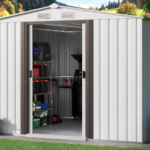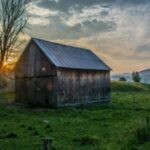The shed siding you choose will not only impact the overall aesthetic of your shed, but also the maintenance you will need to factor-in over the long haul. With so many options to choose from, it can be overwhelming to decide which one is best suited for your needs.
I put together a handy guide to help you think through the most common shed materials, and some other considerations when thinking about which siding to use on your shed.
Understanding Shed Siding Materials
Just like with a house, each siding material has its own set of pros and cons.
Wood Siding
Wood siding is a classic choice for shed siding, and for a good reason. It offers a natural, rustic look that complements most homes and landscapes. It tends to look good when kept painted. Wood siding is also relatively easy to install, making it a popular choice for DIYers. However, wood siding requires regular maintenance, including staining or painting every few years. It is also susceptible to rot, insects, and weather damage.
relatively easy to install, making it a popular choice for DIYers. However, wood siding requires regular maintenance, including staining or painting every few years. It is also susceptible to rot, insects, and weather damage.
Pros:
- Natural, neat look
- Easy to install
- Complements most homes and landscapes
Cons:
- Requires regular maintenance
- Susceptible to rot, insects, and weather damage
- Doesn’t do well when in contact with the ground
Vinyl Siding
Vinyl siding is a popular choice for shed siding due to its low maintenance requirements and durability. It is resistant to rot, insects, and weather damage, making it an excellent choice for areas with harsh weather conditions. Vinyl siding also comes in a variety of colors and styles, allowing you to customize the look of your shed. Vinyl siding can be more expensive than other options, and it may not offer the same natural look as wood or other materials.
Vinyl siding can be more expensive than other options, and it may not offer the same natural look as wood or other materials.
Pros:
- Low maintenance requirements
- Resistant to rot, insects, and weather damage
- Comes in a variety of colors and styles
Cons:
- More expensive than other options
- May not offer a natural look
- Low-quality vinyl can become faded and unattractive
Engineered Wood
Engineered wood siding is a composite material made from wood fibers and resin. It usually has a look of natural wood siding without the same maintenance requirements. Engineered wood siding is also resistant to rot, insects, and weather damage, making it a durable choice for shed siding. Price-wise, it can be more expensive than traditional wood siding, and it may not offer the same level of customization as other materials.
Pros:
- Offers the look of natural wood siding
- Resistant to rot, insects, and weather damage
- Low maintenance requirements
Cons:
- More expensive than traditional wood siding
- May not offer the same level of customization
- Harder to install than wood
Metal Siding
Metal siding is a durable and low-maintenance choice for shed siding. My experience is that metal siding will help a shed last forever. It is resistant to rot, insects, and weather damage, and it is fire-resistant, making it a good choice for areas at risk of wildfires. Metal siding also comes in a variety of colors and styles, allowing you to customize the look of your shed. The downside is that metal siding can be more challenging to install than other options, and it may not offer the same natural look as wood or other materials.
Pros:
- Durable and low-maintenance
- Resistant to rot, insects, and weather damage
- More fire-resistant
Cons:
- More challenging to install than other options
- May not offer a natural look
- Can fail in areas with lots of high winds
Fiber Cement Siding
Fiber cement siding is a composite material made from cement, sand, and cellulose fibers. It has a natural look similar to wood siding, but with less maintenance requirements. Fiber cement siding is also resistant to rot, insects, and weather damage, making it a durable choice for shed siding. Like any maintenance-free siding, it is more expensive than other options, and it may not offer the same level of customization as other materials.
Pros:
- Offers a natural look similar to wood siding
- Resistant to rot, insects, and weather damage
- Low maintenance requirements
Cons:
- More expensive than other options
- May not offer the same level of customization – colors, etc.
- Requires special skills to install
What to Think About for your Shed Siding
When it comes to choosing the right siding for your shed, there are several factors to consider. The siding you choose will impact the durability, maintenance, aesthetic appeal, cost, and installation of your shed. Here are some things to keep in mind when choosing shed siding:
Durability
One of the most important factors to consider when choosing shed siding is durability. Your siding should be able to withstand extreme weather conditions like rain, heat, and cold. It should also be able to resist pests and moisture to protect your tools and equipment. Metal siding is a good option for durability, as it is fire-resistant and requires little upkeep. Vinyl siding is also a durable option that is resistant to moisture and rot.
Maintenance
The amount of maintenance required for your shed siding is another important factor to consider. Some materials, like wood, require regular upkeep to maintain their appearance and performance. High-quality vinyl or steel siding, on the other hand, is very low-maintenance and will require little effort to keep it looking new.
Aesthetic Appeal
The aesthetic appeal of your shed siding is also an important factor to consider. The siding you choose will affect the overall look of your shed and can either
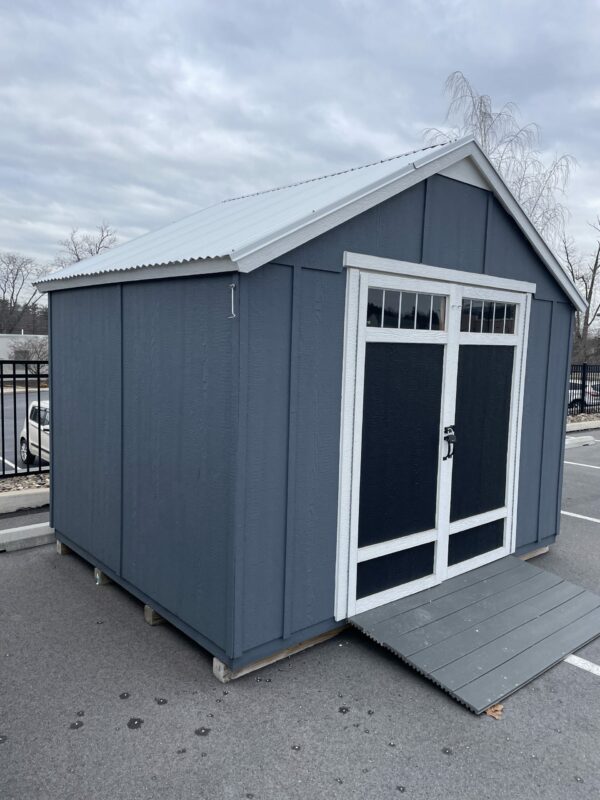
complement or clash with the rest of your property. There are many different materials and styles to choose from, so take some time to browse your options before making a final decision. Cedar siding, for example, has a natural beauty that can enhance your property’s curb appeal.
Some municipalities or HOAs will have shed codes and rules requiring the shed to have a certain look, perhaps matching your house.
Cost
Cost is another important factor to consider when choosing shed siding. Some materials, like wood, are low cost but require regular maintenance to keep them in good condition. Other materials, like metal or vinyl, are more expensive upfront but require little upkeep. Consider your budget and long-term maintenance costs when choosing shed siding.
Installation
Think about the installation requirements for your shed siding, especially if you want to DIY. The majority of siding features an interlocking design, which makes installation easier. Some sidings are also easy to cut and mold around irregularly shaped corners and areas of your shed. If you don’t want a lot of hassle, you can hire a pro or choose a siding that is quick to install, lightweight, and agile while remaining durable.
Popular Shed Siding Styles
Siding materials are only part of the equation. The style of the siding is entirely different. Here are a few key terms to know as you start looking.
Traditional Lap
Traditional lap siding is a classic choice for sheds. It is made up of long, horizontal boards that overlap each other to create a layered look. This style is versatile and can be made from a variety of materials, including wood, vinyl, and fiber cement.
Shingle Siding
Shingle siding is another popular option for sheds. It is made up of small, rectangular pieces that are layered on top of each other to create a textured look. Shingle style is often used on cottages and other small buildings, but can also be used on sheds for a unique look. Many find it more attractive than the other options.
Board and Batten
Board and batten siding is a rustic style that is often used on barns and other farm buildings. It is made up of wide, vertical boards that are separated by narrow strips of wood called battens. This style is often used on sheds to create a country or farmhouse look. It is a great look for a shed if you want a splash of cottage style.
Vertical Panels
Vertical panel siding is a modern style that is becoming increasingly popular for sheds. It is made up of long, vertical panels that give the shed a sleek, contemporary look. This style is often made from metal or fiber cement, but can also be made from wood or vinyl.
Maintenance Tips for Shed Siding
When it comes to maintaining your shed siding, there are a few things to keep in mind to ensure its longevity. The type of material you choose will determine the amount of maintenance required, but regardless of the material, regular upkeep is necessary to prevent damage and prolong the life of your shed.
One important factor to consider is the climate in your area. If you live in an area with harsh weather conditions, such as extreme heat or heavy rainfall, you may need to perform maintenance more frequently. It’s important to inspect your shed siding regularly for any signs of damage, such as cracks, warping, or discoloration.
Here are a few maintenance tips for your shed’s siding, regardless of which option you choose.
- Clean your shed siding regularly. This can be done with a simple solution of soap and water, or a specialized cleaner if necessary. Be sure to rinse thoroughly and avoid using abrasive materials that could scratch or damage the siding.
- Check for any signs of damage, such as cracks or holes, and repair them as soon as possible. This will prevent further damage and ensure your shed remains watertight. Damage tends to have a domino effect. For example, when a shed develops a hole in the siding, woodpeckers cause more damage because they believe it is a hollow tree where they will find food. That’s just one example.
- Keep the area around your shed clear of debris and vegetation. This will prevent moisture buildup and potential damage to the siding. Don’t let things like dirt piles or yard waste bags lean against your shed – it could accelerate rot.
- Consider adding a protective coating to your shed siding. This can help prevent damage from UV rays and other environmental factors.
- Keep the shed painted. If your siding requires paint, be proactive and paint the shed at regular intervals. Letting any wood – whether it is a shed or a fence – get weathered can accelerate its demise to the point where it never has the same strength or durability, even after you paint it.


